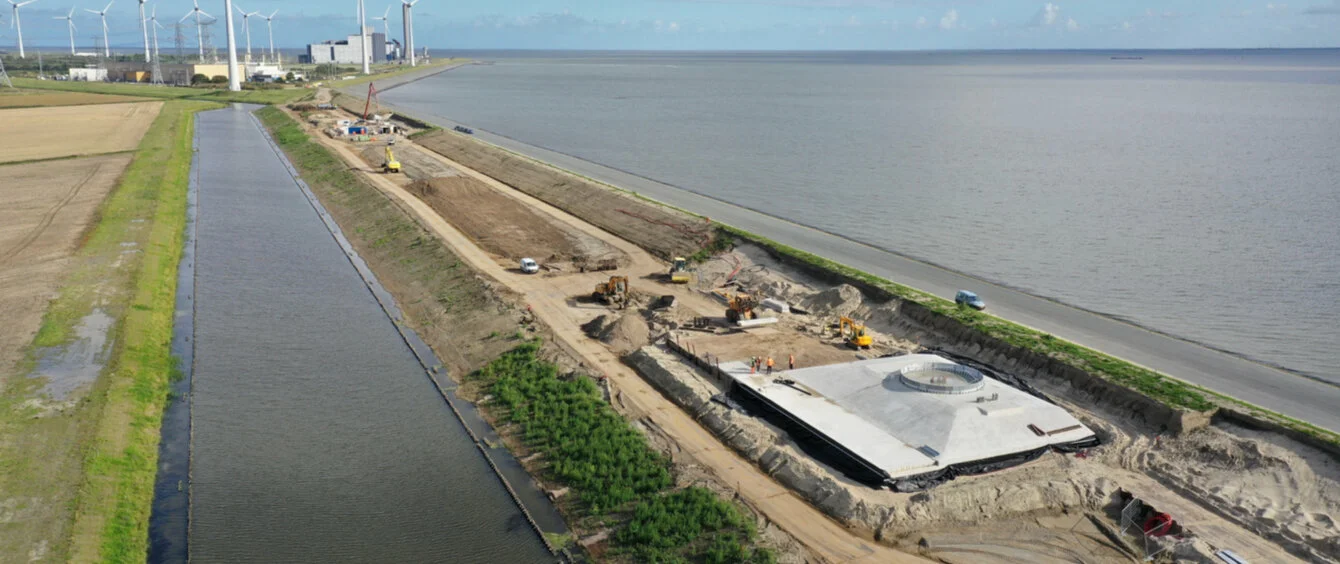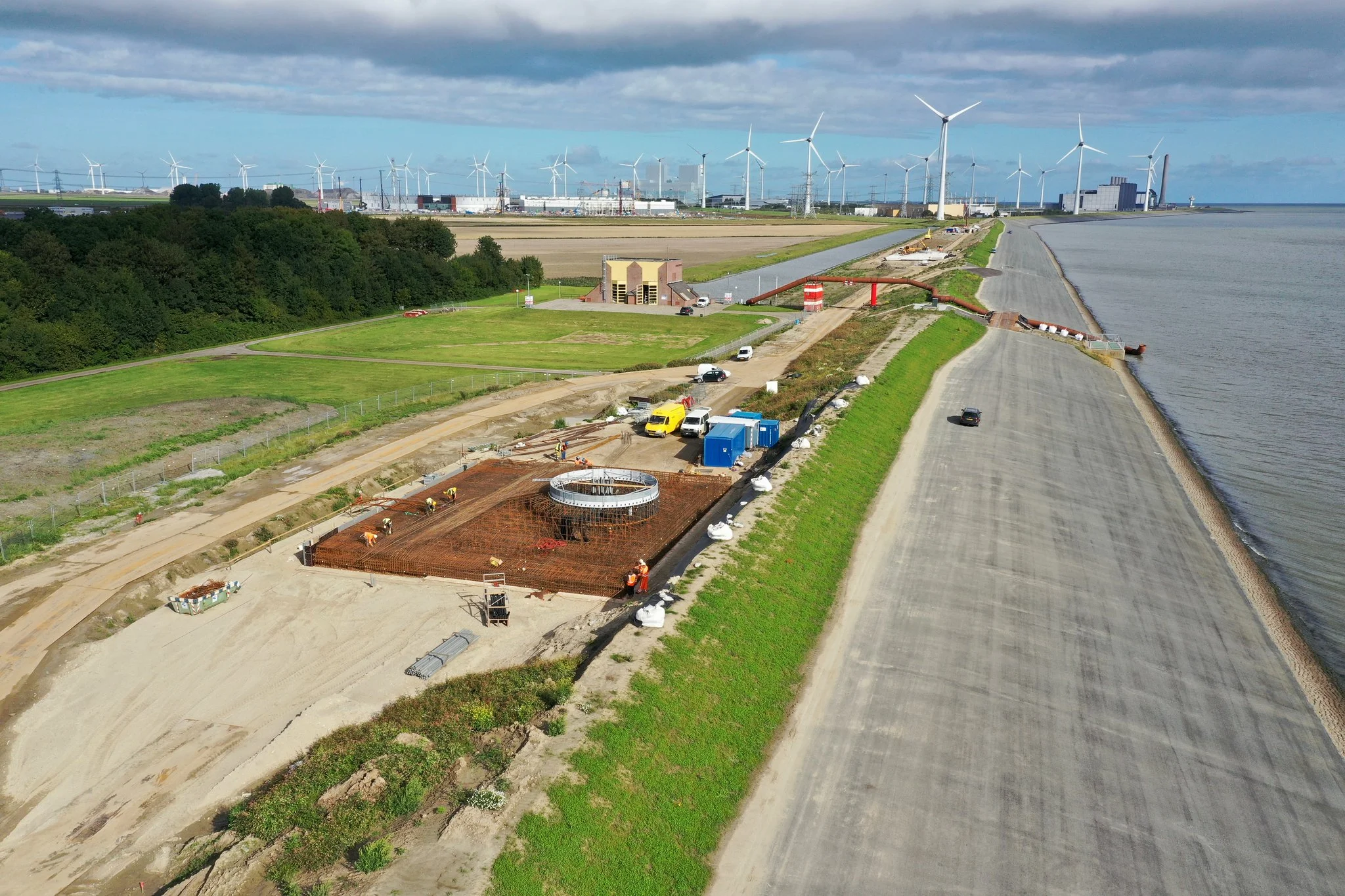If you stand on the Oostpolder dyke on the Dutch North Sea coast and look inland, you will be able to spot a fair few wind turbines. In fact, you will be able to count at least 80 of them, which are all located near the ocean. As the province of Groningen generates a lot of electricity, the three new wind turbine construction sites that have recently appeared – the concrete foundations of which have already been laid – may not seem out of sorts at first glance. And yet, this is where energy provider innogy’s newest innovative pilot project is taking shape. In the first half of 2020, this will soon be home to the first wind turbines ever to be built on primary seawall. Or to be precise, on primary flood defenses.
The challenge in this instance is that the wind turbines, weighing many thousands of tonnes apiece, are not allowed to impact the structure of the dyke or affect the flood protection as a whole in any way. In fact, ideally, they should reinforce the system. So, faced with this challenge, innogy has come up with a whole new design. To make matters slightly more complicated, there isn’t actually enough room on the dykes for the massive construction cranes which are normally needed to erect wind turbines. Once again, the engineers have found a way around this issue. Specially made climbing cranes, produced by wind turbine manufacturer Lagerwey, will simply be used instead.
Advantages: good wind conditions and distance to local settlements
Martine van Gemert, project developer at innogy, explains exactly how this lengthy research and development work has paid off. “Wind turbines on dykes have numerous benefits, given that sea dams, which are used to protect against flooding, are ideal sites for wind energy.” Due to their location, they boast fantastic wind conditions, similar to those at high sea. This makes high capacity utilisation a realistic expectation. At the same time, the impact on the local population is relatively small, as the closest settlements are generally located quite a way away.
“Wind turbines on dykes have numerous benefits, given that sea dams, which are used to protect against flooding, are ideal sites for wind energy.” Martine van Gemert, project developer at innogy
“Wind turbines can also help protect against flooding”, says Martine van Gemert. Given that wind power operators pay usage fees for their plants, they thus contribute financially to the maintenance of the dykes – in return, the relevant levies for the surrounding population fall.
Technology could open up many new possible locations
This could also help to attract locals to build the new plants. Specifically as wind energy has been facing public acceptance issues in densely populated areas such as the Netherlands and Germany, in particular. Local public campaigners fight the construction of wind turbines and bombard projects with complaints, whilst approval procedures are often protracted, extending over several years. This makes the idea of using dykes as sites for wind turbines even more tempting as the surrounding area is usually sparsely populated and the artificial dams themselves have always had an environmental impact.
With the help of technology, expansive areas could become usable for wind energy, as proven by the example of the Netherlands. According to innogy, the dykes along coasts and rivers extend over approx. 3,500 kilometres. “If we install wind turbines on just ten percent of that area, we could generate around 10,000 gigawatt hours of electricity a year,” explains the project developer. That would be roughly equivalent to the amount of electricity generated by wind turbines in the Netherlands in 2017. Wind turbines on dykes could therefore make an important contribution to achieving climate targets.
Flood protection as the number one priority
So the potential is huge, but so are the challenges. “The first and perhaps greatest hurdle was that it simply wasn’t allowed,” says Martine van Gemert. innogy has been in talks with the local Noorderzijlvest association for several years now. As the owner of the dyke, it is responsible for flood protection and had to approve the project. In order to bring those responsible around to the idea, since 2012, the energy provider has conducted extensive research into ways in which wind turbines could be built and operated on a dyke. And their efforts have not been in vain. In 2017, both parties signed an agreement.
Tests quickly revealed that the requirements were very different from those on land. A dyke consists of several layers of soil, each of which serves a specific purpose. As a whole, they should provide the best possible protection against flooding. This means that conventional foundations – deep piles embedded in the ground – would increase the risk that water would penetrate into the various layers and endanger the stability of the mounds. “We therefore had to come up with a completely new design concept,” explains the project developer. Essentially because the foundations need to be wider, in order to prevent them from being so deep. A large plate absorbs the forces generated by the wind turbine. innogy has built around 30 cement walls into the dyke for this purpose.
However, not only the underground work, but also the construction efforts up top are more difficult, as there is no room on the dyke for the large construction cranes. As a result, innogy has opted to use climbing cranes made by wind turbine manufacturer Lagerwey. The trick is that the crane is attached directly to the construction and builds the turbine gradually, one segment after the other. With each attached segment, the crane moves higher and therefore requires much less space on the ground. Three wind turbines, each with a capacity of 2.5 megawatts (MW), are being built on the Oostpolder dyke.
This is how the Lagerwey climbing crane works
A niche market with potential
The combined output of 7.5 MW for the three wind turbines on the dyke is relatively low compared to other wind farms. Martine van Gemert explains: “We have clearly set our sights on research and development and have learned a lot, which could also be relevant to other projects.” How wind turbines can be built when there is limited available space for the structure is only one such example. Once the wind turbines have been installed in a few months, their operation and the supposed impact on flood protection will be closely monitored.
So far this is still a niche market, explains the project developer. But if the technology proves to be a success, wind turbines on dykes could become the norm. Given the many potential new locations, they could help drive the energy transition.
Photo credits: flickr, Dijkverbetering Eemshaven-Delfzijl

